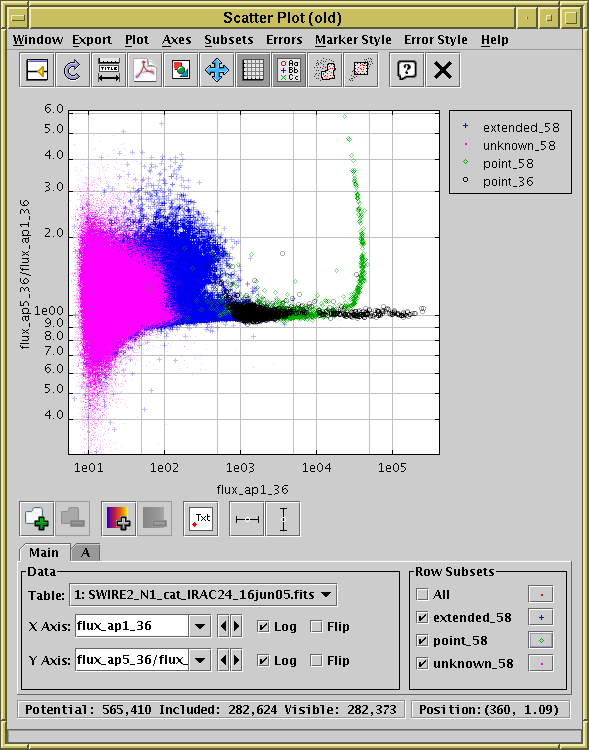Next Previous Up Contents
Next: Plot Style Editor
Up: Old-Style Plot Windows
Previous: Histogram Style Editor
This section describes an old-style plotting window.
The standard plotting windows are described in Appendix A.4.

Plot Window
The plot window allows you to do 2-dimensional scatter plots of
one or more pair of table columns (or derived quantities).
You can display it using the Plot ( ) item
in the Control Window's
Graphics menu.
) item
in the Control Window's
Graphics menu.
On the plotting surface a marker is plotted for each row in the
selected dataset(s)
at a position determined by the
values in the table columns selected to provide the X and Y values.
A marker will only be plotted if both the X and Y values are not blank.
Select the quantities to plot and the plotting symbols with the
dataset selector
at the bottom.
You can configure the axes, including zooming in and out,
with the mouse (drag on the plot or the axes)
or manually as described in Appendix A.5.1.2.
Clicking on any of the plotted points will activate it -
see Section 8.
The following buttons are available on the toolbar:
-
 Split Window
Split Window
- Allows the dataset selector to be resized by dragging a separator
between it and the plot area. Good for small screens.
-
 Replot
Replot
- Redraws the current plot. It is usually not necessary to
use this button, since if you change any of the plot characteristics
with the controls in this window the plot will be redrawn
automatically. However if you have changed the data, e.g. by
editing cells in the Data Window,
the plot is not automatically redrawn (since this is potentially an
expensive operation and you may not require it).
Clicking this button redraws the plot taking account of any changes
to the table data.
-
 Configure Axes and Title
Configure Axes and Title
- Pops up a dialogue to allow manual configuration of axis ranges,
axis labels and plot title - see Appendix A.5.1.2.
-
 Export as PDF
Export as PDF
- Pops up a dialogue which will write the current plot as a PDF file.
In general this is a faithful and high quality rendering of what
is displayed in the plot window. However, if plotting is being done
using the transparent markers, the markers will
be rendered as if they were opaque.
Plots with very many points can result in rather large output PDFs.
-
 Export as GIF
Export as GIF
- Pops up a dialogue which will output the current plot to a GIF file.
The output file is just the same as the plotted image that you see.
Resize the plotting window before the export to control the size
of the output GIF.
-
 Rescale
Rescale
- Rescales the axes of the current plot so that it contains all
the data points in the currently selected subsets.
By default the plot will be scaled like this, but it it may have changed
because of changes in the subset selection or from zooming in or out.
-
 Grid
Grid
- Toggles whether a grid is drawn over the plotting surface or not.
-
 Show Legend
Show Legend
- Toggles whether a legend showing how each data set is represented
is visible to the right of the plot. Initially the legend is shown
only if more than one data set is being shown at once.
-
 Draw Subset Region
Draw Subset Region
- Allows you to draw a region on the screen defining a new
Row Subset. When you have finished
drawing it, click this button again to indicate you're done.
See Appendix A.5.1.6 for more details.
-
 Subset From Visible
Subset From Visible
- Defines a new Row Subset
consisting of only the points which
are currently visible on the plotting surface.
See Appendix A.5.1.6 for more explanation.
The Dataset Toolbar contains the following options:
-
 /
/  Add/Remove dataset
Add/Remove dataset
- Adds/removes tabs in which the data for extra datasets can be entered.
See Appendix A.5.1.1.
-
 /
/  Add/Remove auxiliary axis
Add/Remove auxiliary axis
- Adds/removes a selector for entering an auxiliary axis to modify
point colours etc.
See Appendix A.5.1.5.
-
 Toggle point labelling
Toggle point labelling
- Allows text labels to be drawn near plotted points.
See Appendix A.5.1.4.
-
 /
/  Toggle X/Y error bars
Toggle X/Y error bars
- Switches between drawing symmetric error bars and no error bars
in the X and Y directions respectively.
Other options are available in the Errors menu.
See Appendix A.5.1.3.
You have considerable freedom to configure how the points are
plotted including the shape, colour and transparency of symbols,
the type of lines which join them if any, and the representation of
error bars if active. These options are described in the following
subsection.
Next Previous Up Contents
Next: Plot Style Editor
Up: Old-Style Plot Windows
Previous: Histogram Style Editor
TOPCAT - Tool for OPerations on Catalogues And Tables
Starlink User Note253
TOPCAT web page:
http://www.starlink.ac.uk/topcat/
Author email:
m.b.taylor@bristol.ac.uk
Mailing list:
topcat-user@jiscmail.ac.uk


![]() ) item
in the Control Window's
Graphics menu.
) item
in the Control Window's
Graphics menu.